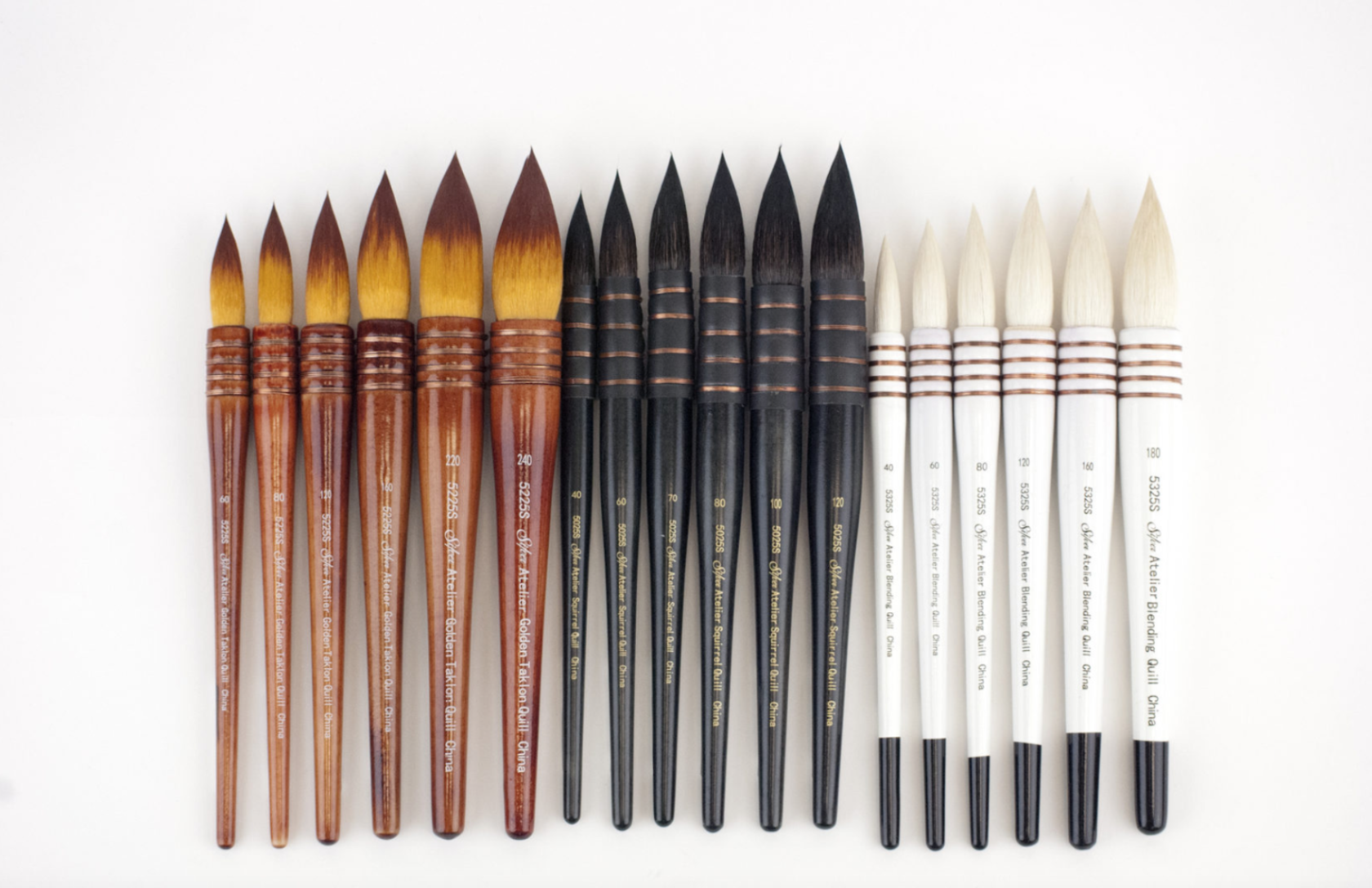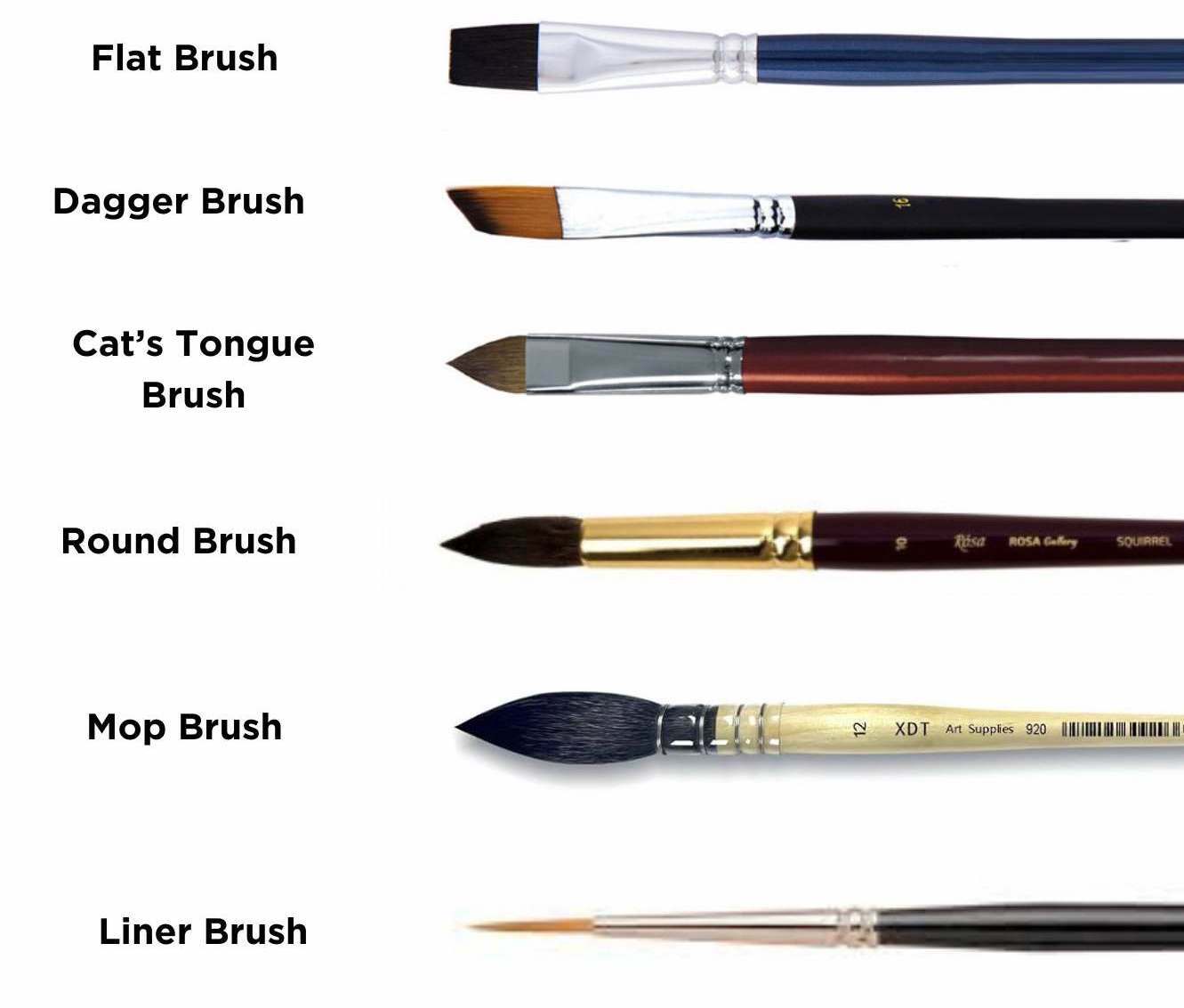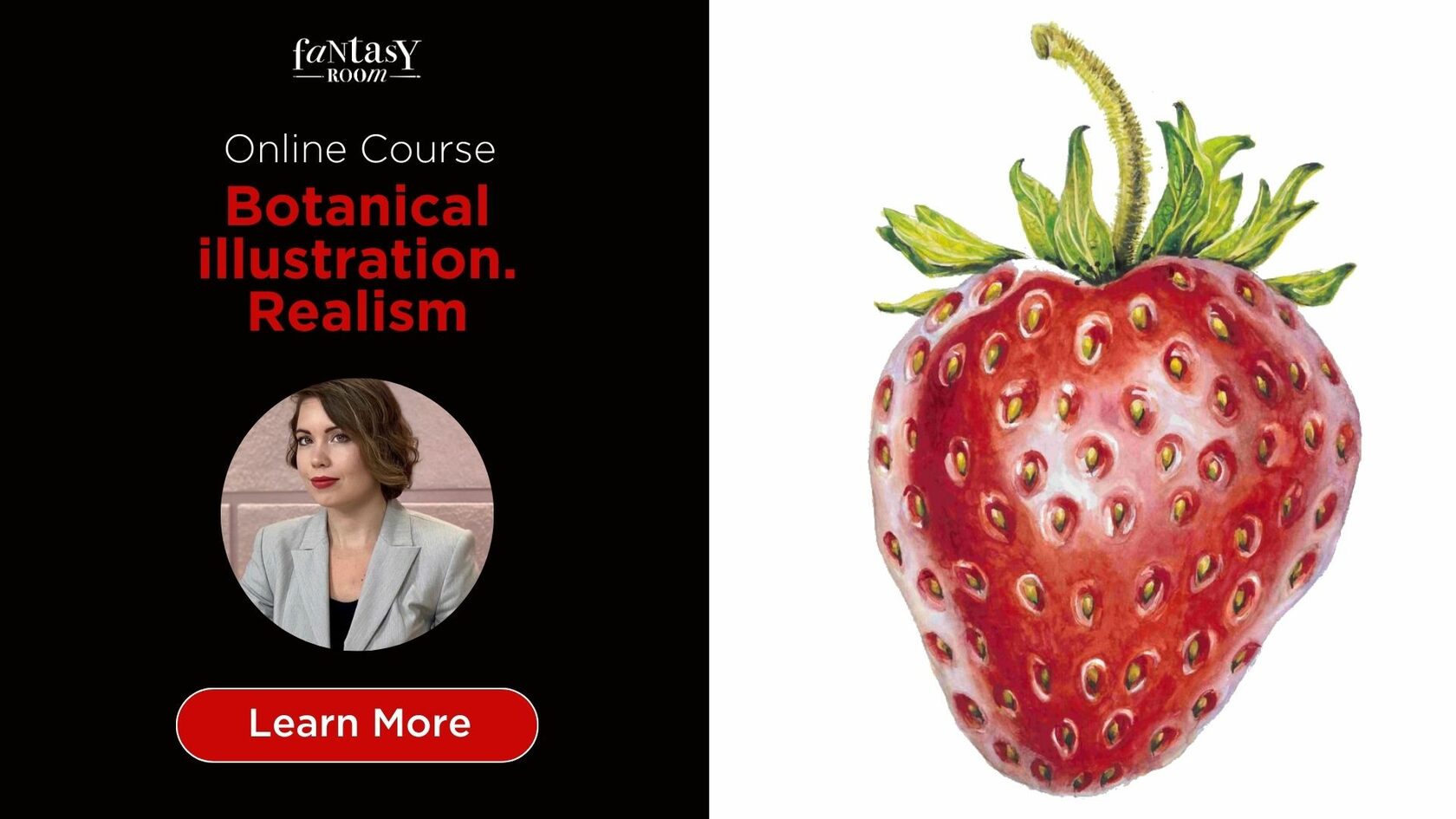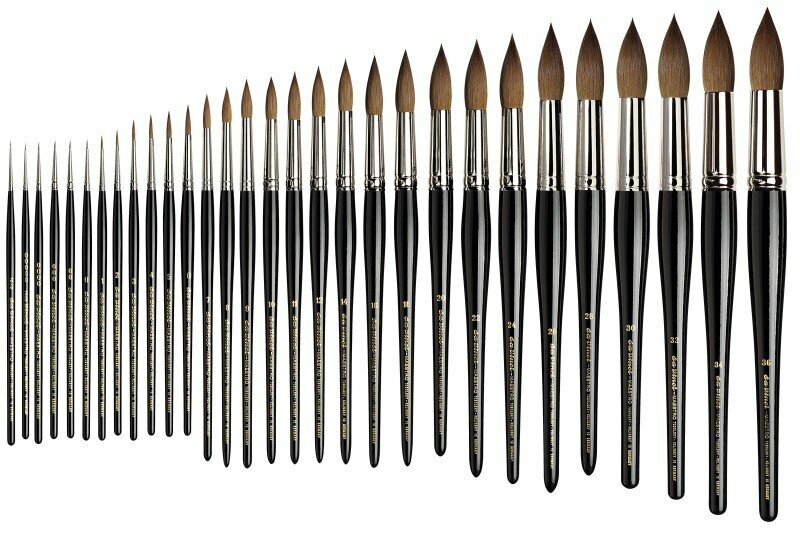Watercolor brushes stand as essential tools for anyone venturing into watercolor painting. While beginners often opt for extensive brush sets featuring numerous types and sizes, the reality is that many brushes in these sets remain untouched, leading to unnecessary waste.
In truth, only a handful of watercolor brushes is required to commence painting. The challenge lies in selecting the right brushes amid the plethora of options available. How can you ensure you find the perfect brushes without squandering time and money?
This comprehensive guide covers everything you need to know about watercolor brushes – from hair type to size and shape – empowering you to make informed choices tailored to your artistic preferences.
In truth, only a handful of watercolor brushes is required to commence painting. The challenge lies in selecting the right brushes amid the plethora of options available. How can you ensure you find the perfect brushes without squandering time and money?
This comprehensive guide covers everything you need to know about watercolor brushes – from hair type to size and shape – empowering you to make informed choices tailored to your artistic preferences.
Animal hair brushes
Watercolor brushes come in two main variants: those crafted with animal hair and their synthetic counterparts designed to replicate the properties of animal hair.
Real hair brushes, typically more expensive than their synthetic counterparts, boast unique advantages. The natural hairs possess microscopic scales that enhance water retention, and their soft, delicate nature contributes to a smooth painting experience.
Squirrel hair brushes are a distinctive and cherished choice among watercolor artists for their unique qualities. These brushes are known for their softness, absorbency, and the ability to hold a considerable amount of water. The fine, delicate nature of squirrel hair allows for a smooth and controlled application of watercolor pigments.
Real hair brushes, typically more expensive than their synthetic counterparts, boast unique advantages. The natural hairs possess microscopic scales that enhance water retention, and their soft, delicate nature contributes to a smooth painting experience.
Squirrel hair brushes are a distinctive and cherished choice among watercolor artists for their unique qualities. These brushes are known for their softness, absorbency, and the ability to hold a considerable amount of water. The fine, delicate nature of squirrel hair allows for a smooth and controlled application of watercolor pigments.

Synthetic brushes
Synthetic watercolor brushes are crafted to emulate their natural counterparts but are composed of artificial fibers. The most prevalent synthetic hair type is Taklon, often designed in a 'gold' hue to replicate sable hair, although variations in brown or white are also common. Remarkably, modern synthetic brushes exhibit nearly identical painting and performance characteristics to brushes made from animal hair, showcasing comparable quality.
Compared to real hair brushes, synthetic watercolor brushes generally offer a slightly firmer feel and better shape retention, providing artists with enhanced control. This attribute is often described as a favorable 'snap,' signifying that the fibers promptly return to a straight position after being lifted off the paper.
Certain brands produce hybrid brushes that blend both natural and synthetic fibers, aiming to combine the advantages of each while maintaining affordability.
It's important to note that some brands offer both natural and synthetic versions of the same brush. Therefore, careful consideration is advised, especially when making online purchases, to ensure that the intended brush type is selected.
Compared to real hair brushes, synthetic watercolor brushes generally offer a slightly firmer feel and better shape retention, providing artists with enhanced control. This attribute is often described as a favorable 'snap,' signifying that the fibers promptly return to a straight position after being lifted off the paper.
Certain brands produce hybrid brushes that blend both natural and synthetic fibers, aiming to combine the advantages of each while maintaining affordability.
It's important to note that some brands offer both natural and synthetic versions of the same brush. Therefore, careful consideration is advised, especially when making online purchases, to ensure that the intended brush type is selected.

Brush pens
Brush pens prove to be excellent companions for artists on the move or those who enjoy painting outdoors. Crafted with hollow plastic bristles, these innovative pens come equipped with a reservoir inside the handle, allowing you to carry water conveniently. By gently squeezing the pen, water is pushed into the bristles, eliminating the need for a separate water jar while traveling. Simply unscrew the pen to load it with water, give it a gentle squeeze, and you're ready to start painting on the go!

Watercolour brush types by shape
Round brushes stand out as the most commonly used brushes in watercolor painting. Their designation is derived from the round ferrule, the metallic component of the brush. Particularly favored by watercolor beginners, round brushes serve as versatile tools, combining a pointed tip for intricate strokes and a broader belly for more substantial coverage when pressed onto the paper.
These brushes are sized numerically, with larger numbers indicating wider brushes. A popular choice among watercolorists is the size 6 round brush, offering a versatile medium size. Smaller brushes like size 2 are ideal for intricate details, while larger sizes such as 12 or 16 cater to expansive, expressive work.
Cat's tongue brushes feature a flat ferrule with bristles that are rounded over the edge, often forming a slight point in the middle. These brushes offer versatility, allowing artists to use them flat for creating oval shapes or on their sides to produce intriguing marks. Experimenting with twisting a cat's tongue brush while executing strokes can result in unique and unconventional shapes in your artwork.
Liner brushes, also known as riggers, are characterized by their long, thin bristles, making them well-suited for creating smooth, elongated lines. These brushes prove invaluable for rendering botanical elements such as grass or reeds, as well as outlining shapes in abstract compositions. Their precision and ability to deliver fine lines make liner brushes essential tools for detailed and intricate work in watercolor painting.
These brushes are sized numerically, with larger numbers indicating wider brushes. A popular choice among watercolorists is the size 6 round brush, offering a versatile medium size. Smaller brushes like size 2 are ideal for intricate details, while larger sizes such as 12 or 16 cater to expansive, expressive work.
Cat's tongue brushes feature a flat ferrule with bristles that are rounded over the edge, often forming a slight point in the middle. These brushes offer versatility, allowing artists to use them flat for creating oval shapes or on their sides to produce intriguing marks. Experimenting with twisting a cat's tongue brush while executing strokes can result in unique and unconventional shapes in your artwork.
Liner brushes, also known as riggers, are characterized by their long, thin bristles, making them well-suited for creating smooth, elongated lines. These brushes prove invaluable for rendering botanical elements such as grass or reeds, as well as outlining shapes in abstract compositions. Their precision and ability to deliver fine lines make liner brushes essential tools for detailed and intricate work in watercolor painting.

Mop watercolor brushes, characterized by their large round shape, excel in holding a substantial amount of water. Typically crafted from real animal hair, these brushes exhibit a much softer texture compared to round brushes. The bristle shape of mop brushes undergoes changes as you work, avoiding a snap-back into place when the brush is lifted, offering a unique quality to the painting process. While mop brushes might pose a challenge for beginners in terms of control, they provide the freedom to explore a more relaxed and expressive painting style.
It's important to note that mop brush sizes differ from regular round brushes – for instance, a size 6 mop is considerably large, while a size 0 serves as a versatile medium option.
Flat watercolor brushes, on the other hand, feature a flat ferrule and typically short, squared bristles. Renowned for their effectiveness in creating lines, defining edges, and forming geometric shapes, flat brushes are also well-suited for watercolor washes. The larger size of a flat brush allows for quick coverage of the paper, ensuring an even distribution of water content, making it ideal for achieving seamless blending in your artwork.
It's important to note that mop brush sizes differ from regular round brushes – for instance, a size 6 mop is considerably large, while a size 0 serves as a versatile medium option.
Flat watercolor brushes, on the other hand, feature a flat ferrule and typically short, squared bristles. Renowned for their effectiveness in creating lines, defining edges, and forming geometric shapes, flat brushes are also well-suited for watercolor washes. The larger size of a flat brush allows for quick coverage of the paper, ensuring an even distribution of water content, making it ideal for achieving seamless blending in your artwork.

Choosing the best brush size for watercolor painting
A popular choice among watercolorists is the size 6 round brush, providing a versatile medium size for various applications. Smaller round sizes like 2 or 1 are ideal for intricate details, while larger sizes such as 12 or 16 round brushes are well-suited for expansive, free-flowing work and watercolor washes.
For those interested in mop brushes, it's important to note that mop brush sizes differ from regular round brushes. A size 6 mop, for instance, is considerably large. Starting with a size 2 mop is recommended for those seeking a medium-sized option.
Typically, these three sizes – 6, 2, and 12 or 16 – offer ample variety for beginners venturing into watercolor painting. As you delve further into the art, you'll naturally discover which sizes you prefer based on your individual painting style and preferences.
For those interested in mop brushes, it's important to note that mop brush sizes differ from regular round brushes. A size 6 mop, for instance, is considerably large. Starting with a size 2 mop is recommended for those seeking a medium-sized option.
Typically, these three sizes – 6, 2, and 12 or 16 – offer ample variety for beginners venturing into watercolor painting. As you delve further into the art, you'll naturally discover which sizes you prefer based on your individual painting style and preferences.

What are the best watercolour brushes for beginners?
Discovering the ideal watercolor brush largely hinges on personal preferences. Art supplies are inherently subjective, and what may be favored by one person might not suit another.
Here are my key suggestions for identifying the best watercolor brush for your needs:
Remember, experimenting with different brushes and understanding your personal preferences is key to finding the best watercolor brush that suits your unique artistic style.
Here are my key suggestions for identifying the best watercolor brush for your needs:
- Begin with Synthetic Brushes: For many beginners, synthetic brushes are often easier to control. They offer a good starting point for those new to watercolor painting.
- Include a Round Brush in Your Collection: A round brush is highly versatile and a must-have in your toolkit. It can effortlessly create both thick and thin strokes, essentially providing the functionality of two brushes in one.
- Prioritize a Pointy Tip: When selecting round brushes, look for ones with a sharp and pointy tip. This feature enhances precision in your brushwork.
- Ensure Uniform Hair Direction: Quality round brushes should have all their hairs pointing in the same direction. Avoid cheaper brushes where hairs may be scattered in different orientations. Once a bristle becomes damaged, rectifying it becomes more challenging.
Remember, experimenting with different brushes and understanding your personal preferences is key to finding the best watercolor brush that suits your unique artistic style.











